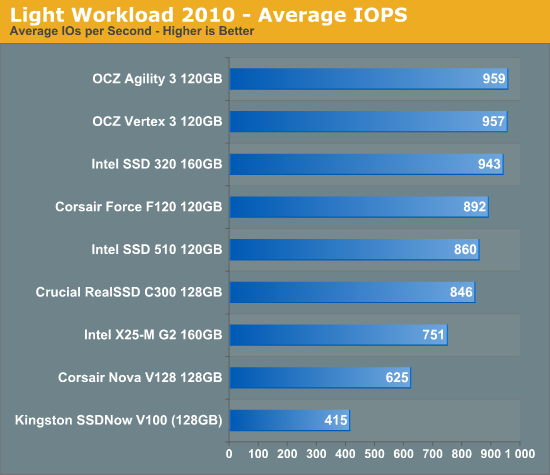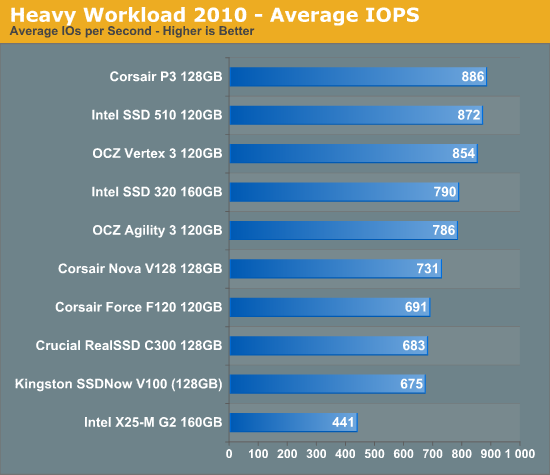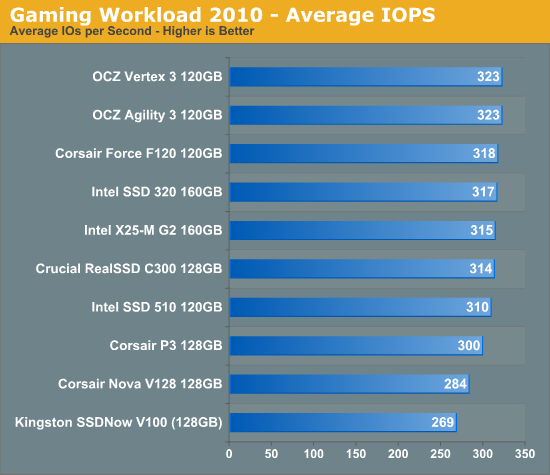The 2011 Mid-Range SSD Roundup: 120GB Agility 3, Intel 510 and More Compared
by Anand Lal Shimpi on June 7, 2011 12:52 PM ESTAnandTech Storage Bench 2010
To keep things consistent we've also included our older Storage Bench. Note that the old storage test system doesn't have a SATA 6Gbps controller, so we only have one result for the 6Gbps drives.
The first in our benchmark suite is a light/typical usage case. The Windows 7 system is loaded with Firefox, Office 2007 and Adobe Reader among other applications. With Firefox we browse web pages like Facebook, AnandTech, Digg and other sites. Outlook is also running and we use it to check emails, create and send a message with a PDF attachment. Adobe Reader is used to view some PDFs. Excel 2007 is used to create a spreadsheet, graphs and save the document. The same goes for Word 2007. We open and step through a presentation in PowerPoint 2007 received as an email attachment before saving it to the desktop. Finally we watch a bit of a Firefly episode in Windows Media Player 11.
There’s some level of multitasking going on here but it’s not unreasonable by any means. Generally the application tasks proceed linearly, with the exception of things like web browsing which may happen in between one of the other tasks.
The recording is played back on all of our drives here today. Remember that we’re isolating disk performance, all we’re doing is playing back every single disk access that happened in that ~5 minute period of usage. The light workload is composed of 37,501 reads and 20,268 writes. Over 30% of the IOs are 4KB, 11% are 16KB, 22% are 32KB and approximately 13% are 64KB in size. Less than 30% of the operations are absolutely sequential in nature. Average queue depth is 6.09 IOs.
The performance results are reported in average I/O Operations per Second (IOPS):

Our old light workload from 2010 highlights an important point about all of these SSDs. For light usage, in a completely IO bound workload, there's only a 13% difference in performance between the fastest 6Gbps drive and last year's C300. If there's only a 13% difference in this completely IO bound test, the real world difference will surely be nonexistent.
If there’s a light usage case there’s bound to be a heavy one. In this test we have Microsoft Security Essentials running in the background with real time virus scanning enabled. We also perform a quick scan in the middle of the test. Firefox, Outlook, Excel, Word and Powerpoint are all used the same as they were in the light test. We add Photoshop CS4 to the mix, opening a bunch of 12MP images, editing them, then saving them as highly compressed JPGs for web publishing. Windows 7’s picture viewer is used to view a bunch of pictures on the hard drive. We use 7-zip to create and extract .7z archives. Downloading is also prominently featured in our heavy test; we download large files from the Internet during portions of the benchmark, as well as use uTorrent to grab a couple of torrents. Some of the applications in use are installed during the benchmark, Windows updates are also installed. Towards the end of the test we launch World of Warcraft, play for a few minutes, then delete the folder. This test also takes into account all of the disk accesses that happen while the OS is booting.
The benchmark is 22 minutes long and it consists of 128,895 read operations and 72,411 write operations. Roughly 44% of all IOs were sequential. Approximately 30% of all accesses were 4KB in size, 12% were 16KB in size, 14% were 32KB and 20% were 64KB. Average queue depth was 3.59.

Our heavy workload is really no different in terms of the performance spread. All of the newer drives show very similar performance.
The gaming workload is made up of 75,206 read operations and only 4,592 write operations. Only 20% of the accesses are 4KB in size, nearly 40% are 64KB and 20% are 32KB. A whopping 69% of the IOs are sequential, meaning this is predominantly a sequential read benchmark. The average queue depth is 7.76 IOs.











68 Comments
View All Comments
hybrid2d4x4 - Friday, June 10, 2011 - link
Slightly off topic question: in your review of the Agility 3, you guys mentioned that it's lower power characteristics are due to asynchronous NAND. Does the Agility 2 also use this?I want a SSD for a laptop I'm getting within the next 2 months and don't really care as much about performance, just power consumption and bang-for-buck.
tecsi - Monday, June 13, 2011 - link
Appears that Agility3 120GB << 240GB with incompressible data (which apparently is typical).Would we see yet another big performance drop for 60GB? Need to add this review so we can see what we lose.
Perhaps the value of SATA III drops precipitously with each halving of SSD capacity?
tecsi - Monday, June 13, 2011 - link
This would be helpful to see see "real world performance" in ONE place. For example, Agility 3 60GB, 120GB, 240GB and Vertex 3 120GB, 240GB.tecsi - Monday, June 13, 2011 - link
Incompressible Read Speed: Vertex3 (497) 2.5 times faster than Agility 3 (203)? Is this correct? What accounts for this huge difference?erikejw - Friday, July 15, 2011 - link
Beware the Intel SSD 320 (and probably 510 too).Huge number of complete data losses for users.
Intel finally admits the problem exist.
To my knowledge noone has been able to retrieve any data.
-------------------
http://www.fudzilla.com/memory/item/23447-intel-co...
-------------------
"Intel is aware of the customer sightings on Intel SSD 320 Series. If you experience any issue with your Intel SSD, please contact your Intel representative or Intel customer support (via web: www.intel.com or phone: www.intel.com/p/en_US/support/contact/phone) . We will provide an update when we have more information.
Alan
Intel's NVM Solutions Group"
datalaforge - Saturday, July 23, 2011 - link
Thanks for all of the great lineups here. I'm wondering what you guys think about the Samsung 470 SSD. Also why is the Seagate Momentus XT the only Hybrid drive that I can find out there. It seems like such a good idea. Why haven't any competitors given Hybrids a shot?Carlu - Friday, September 16, 2011 - link
A) Can some one explain to me the different in "8GB span" vs "100% span"?http://ark.intel.com/compare/56577,56576,56585,565...
B) And how do I compare them?
drumm_22 - Wednesday, June 6, 2012 - link
I have been reading several of the SSD articles on AnAnd and reading reviews on Newegg. I have recently purchased a Sager notebook to use during my college years as an engineering student. I was wondering if an SSD would be worth the money right now or should i wait for SSD's to become more adavanced at cheaper?